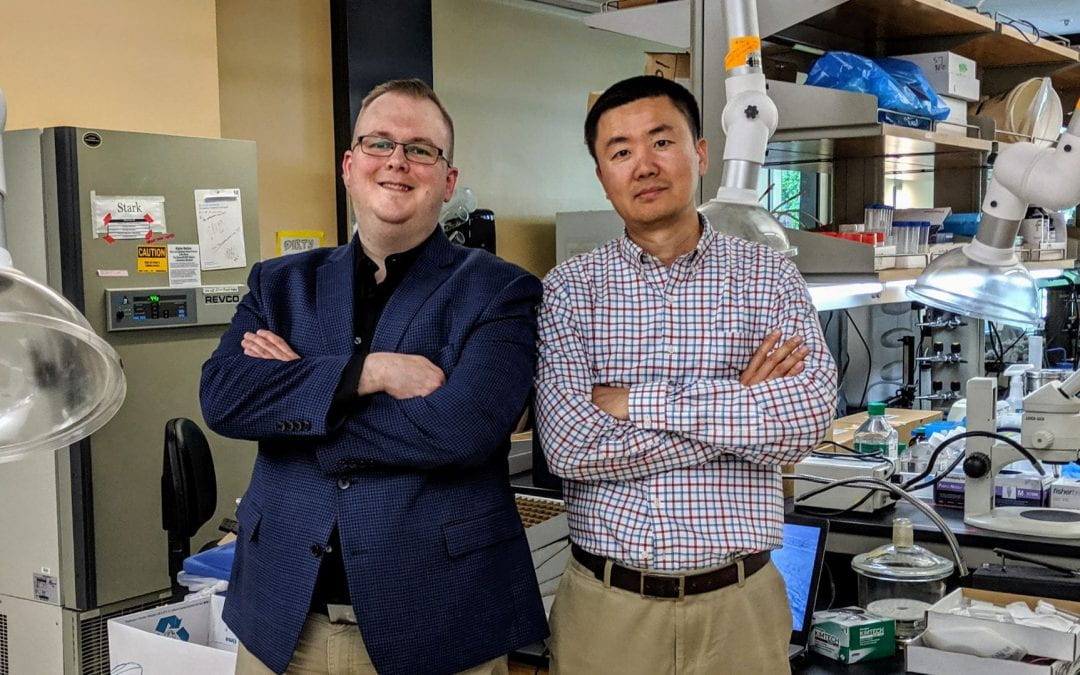A major dilemma faced by many people undergoing chemotherapy for cancer is whether the drugs will cause more harm than good.
“Chemotherapeutic drugs can have serious side effects. Some of the adverse events in chemotherapy, such as heart failure, can even take as long as 10 years to manifest in people down the road,” says Steven E. Johnson, ’16 PhD, former postdoctoral fellow in Chemistry of Life Processes Institute member Ming Zhao’s laboratory.
Johnson and Ming Zhao, PhD, Associate Professor of Medicine in the Division of Cardiology, developed an innovative new imaging technology, published in Clinical Cancer Research, that surveys the entire body’s response to potentially toxic drugs in real time by assessing a marker for cell death.
Pathologically elevated cell death is an unambiguous marker for tissue injury. The collaborators’ initial proof of concept studies began with observation of cellular changes in response to cytotoxic treatments. The scientists took notice of a phenomenon called aminophospholipid externalization, in which a type of phospholipid that resides inside viable cells becomes available for binding of select imaging agents when the cell is dead or dying.
“The technique works by detecting a molecular signature of cell death, which enables the near-real time monitoring of toxic side-effects in target and susceptible tissues,” says Zhao.
The “aha” moment came when the researchers realized that they could apply this technology in a whole-body and dynamic fashion as a survey for drug toxicity by imaging the location of tissue damage in real time throughout the subject.
Excited about the translational possibilities of their research, the pair patented their new technology and started Durametrix to develop its commercial potential. They are working with Northwestern to obtain the license for the invention. Zhao and Johnson applied to NIH for a Small Business Technology Transfer (STTR) grant to test potential applications. Initially, the company would like to roll out the product to pharma industry collaborators and other researchers involved in drug discovery and development. Down the road, they hope to develop it for clinical use.
“When you want to create a new drug, you don’t start with just one molecular entity,” says Johnson, CEO of the new startup. “You start with many different compounds and narrow it down to 4-5 candidates that all look like they could be the drug that you’re going to give somebody eventually. When you test how safe and effective these candidates are, you need to go through hundreds of subjects. These studies are time-consuming, labor-intensive, and very expensive. The average time is about 2-3 years for a good drug discovery company to get to the point where they’ll say, this is what we want to actually push forward into clinical development.
“Our technology could really help drug companies make educated decisions in an expeditious and effective manner saving valuable time and money,” says Johnson.
Throughout the project, Chemistry of Life Processes Institute faculty, technical staff and administrators provided valuable assistance and guidance. Andrew Mazar, Center for Developmental Therapeutics, partnered with the researchers in developing the cytotoxicity paradigm; Chad Haney, managing director, Center for Advanced Molecular Imaging, collaborated on the imaging studies; and Jody Hirsh, senior research administrator, CLP, advised the team on their NIH STTR grant application. The team also tapped the expertise of Developmental Therapeutics Core facility manager, Angki Kandela.
“CLP has all of this expertise under one umbrella. You can jump between cores, collaborate with multiple people and really push a project forward in the best possible way,” says Zhao.
Next up for Durametrix is the development and release of a new, proprietary visualization software that provides easy-to-interpret analytics that pinpoint specific areas of tissue damage, as well as development of a new probe with enhanced chemical properties for clinical use.
by Lisa La Vallee
Photo: Steve Johnson and CLP member Ming Zhao, founders of biotech startup Durametrix
